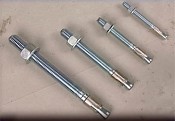Anchors in Concrete Subject to New International Code
8/13/2009
FEATURE

New “Strength Design” concrete anchors (photo courtesy of Powers Fasteners)
Distributors selling anchors which will be installed in concrete need to know about the new International Building Code 2003/06/08, which became effective in January 2009, Jack Zenor told the Western Association of Fastener Distributors.
“For the first time in history, the building code addresses anchors,” the director of business development and national training manager for Powers Fasteners said. “You need to supply code-compliant anchors to your contractor customers. And the code-compliant anchors are available.”
Zenor pointed out that “all concrete cracks and when it concrete cracks, the crack will naturally look for and find its way through a stress-riser in the concrete continuum.”
An example of a stress-riser would be one created by a mechanical or adhesive anchor.
“When load is applied to concrete for example, the load from cars driving through a parking garage the concrete deck bends, creating a ‘tension zone’ or a ‘pulling apart’ effect on the underside of the concrete deck,” Zenor explained. “That tension zone effect induces cracking, those cracks then will seek out mechanical or adhesive anchors installed in that concrete.”
Cracked concrete anchors require more detailed design calculations, the complexity of which will drive engineers to design for the ‘worse case’ conditions. “The result will be specification conditions that require all anchors on a given project comply with the ‘cracked concrete’ criteria,” Zenor explained.
The “cracked concrete” theory began in Europe and spread to the U.S. through the American Concrete Institute (ACI) and the International Building Code.
The IBC 2003/06/08 replaces the obsolete Allowable Stress Design method for concrete anchoring with the new Strength Design method. The Strength Design method “is significantly more complex,” Zenor said. That complexity will drive engineers to look for super-sophisticated software packages to work through the strength design method. Several anchor manufacturers, including Powers, offer design software.
“The new test criteria for anchors is extremely limiting and select anchor types simply will not pass the testing,” Zenor observed. “For example, standard drop-in anchors though functional will not pass the test criteria and thus are not compliant with the code.”
Options for replacing the standard drop-in anchor are proceeding through the code compliance process, Zenor reported. Powers Fasteners’ Vertigo, Snake and Wedge Bolt+ designs are either code compliant or near code compliance and offer a lower total-installed-cost than the standard drop-in anchor.
Code Compliant adhesive anchor formulations designed and tested to meet IBC 2006 (ICC-ES AC 308) also are available, Zenor added.
Approved mechanical fasteners are available such as the Wedge-Bolt+ self-tapping concrete screw anchor (ESR-2526) which works in all forms of masonry base materials and Power-Stud SD1 (ESR 2818) and SD2 (ESR 2502) wedge anchors are also compliant with IBC 2006.
ITW Read Head, Simpson and Powers brands all have fasteners approved for use in cracked concrete, Zenor added.
Zenor, who started in the fastener business in 1979 working for a construction supply distributor, also has worked for Hilti and ITW-Ramset/Red Head.
“How much of your (WAFD distributors) sales will be effected by the issue of ‘cracked concrete’?” Zenor asked rhetorically. “The reality is most of it,” he acknowledged.
Beyond selling IBC code complaint anchors, proper installation is vital, Zenor emphasized. Powers Fasteners offers an online training program, with an exam and a “verification of training” certificate. ©2009 GlobalFastenerNews.com
Related Links:



There are no comments at the moment, do you want to add one?
Write a comment